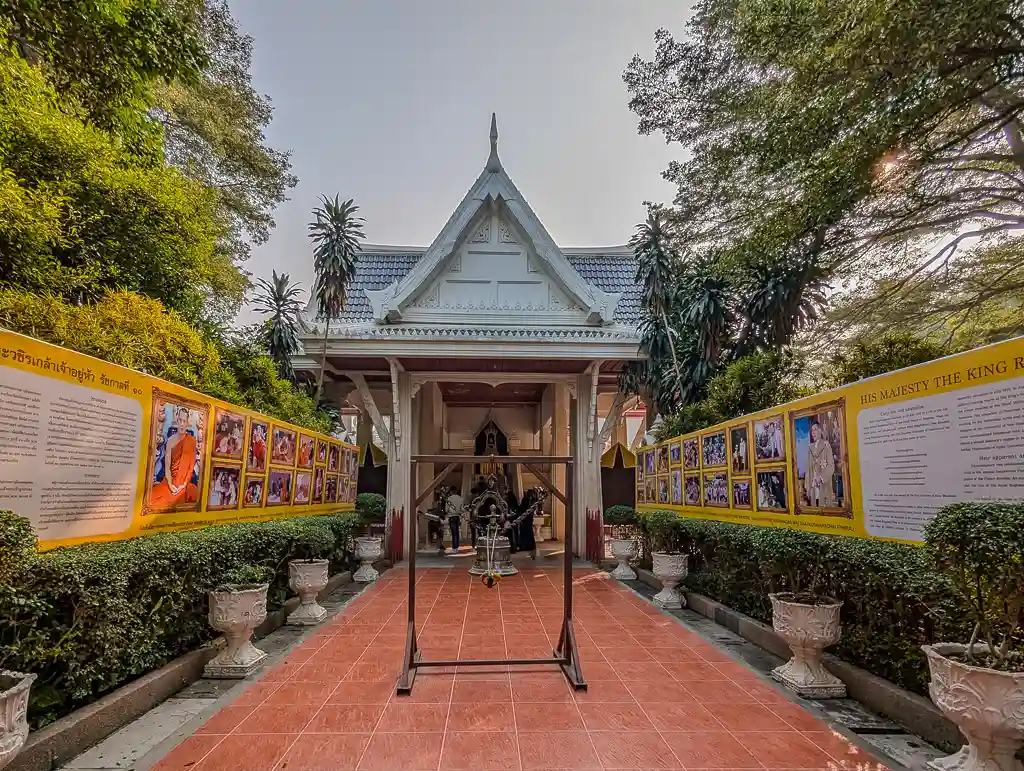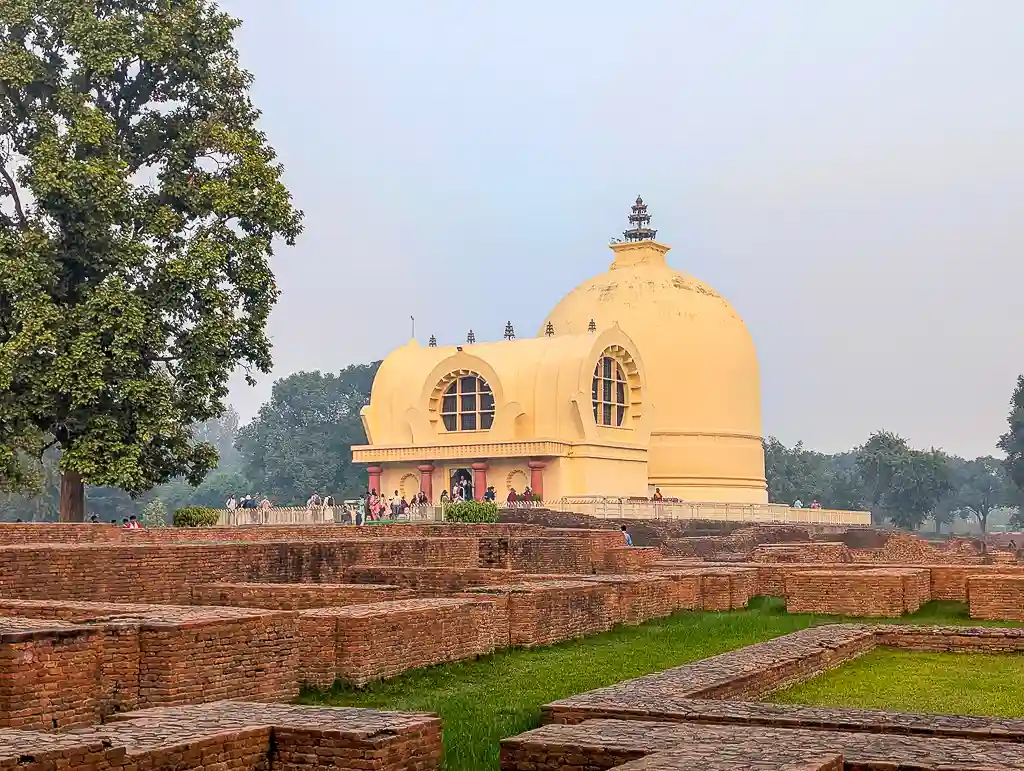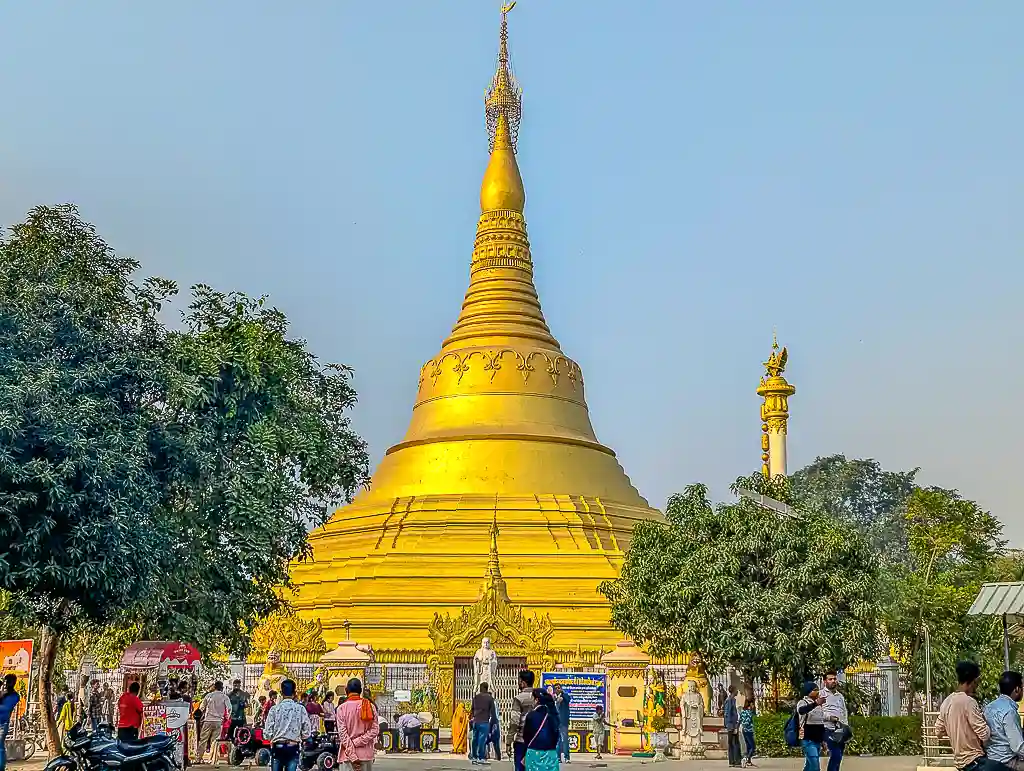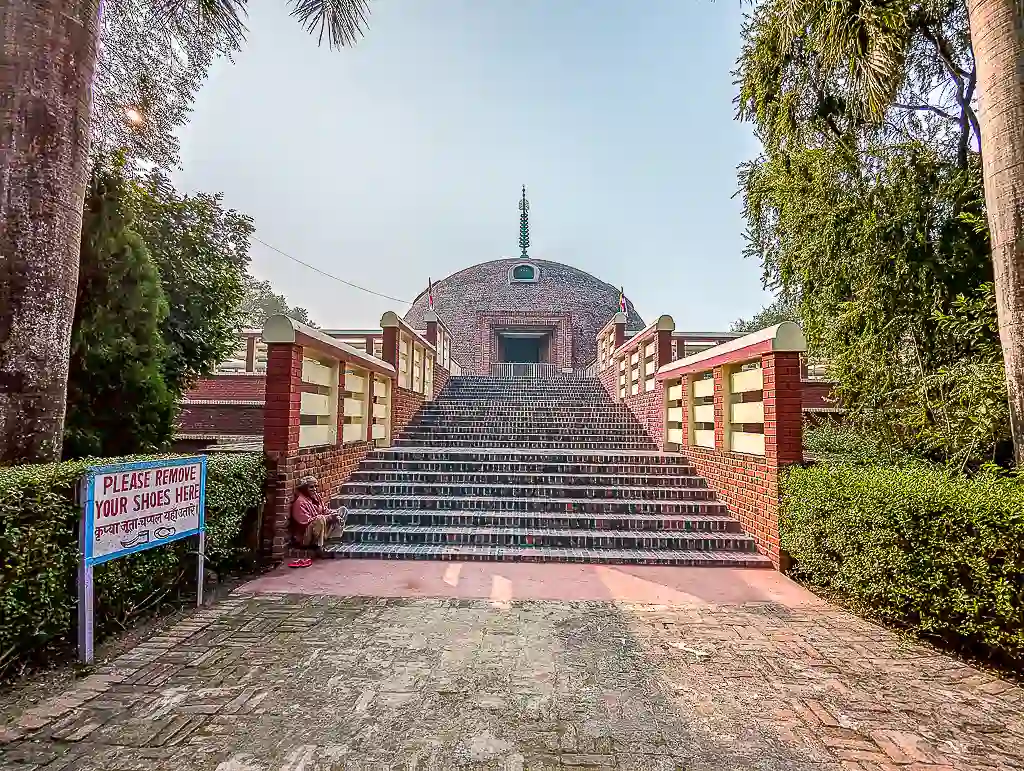Ramabhar Stupa
Ramabhar Stupa is a very important place in Kushinagar, Uttar Pradesh. It is believed to be the spot where Lord Buddha was cremated after he attained Mahaparinirvana (final liberation). Because of this, it is a sacred place for Buddhist pilgrims from all over the world.
This big, round brick stupa is about 15 meters high. It stands peacefully in an open area, surrounded by green fields and trees. The place is very calm, making it perfect for people who want to meditate, pray, or just sit quietly. Many visitors feel a deep sense of peace and respect when they come here.
Timings
- Opening Hours: 6:00 AM – 6:00 PM
- Best Time to Visit: Early morning or late afternoon for a peaceful experience
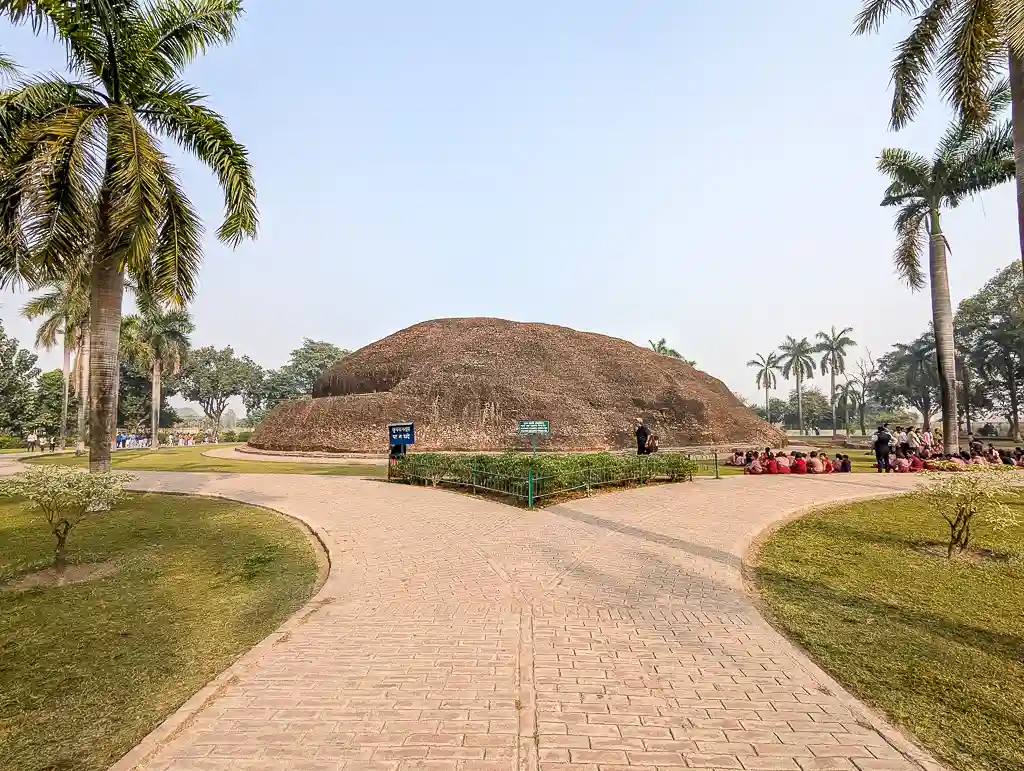
Top Places to Visit Near Ramabhar Stupa
How to Reach the Ramabhar Stupa
Find the Best Hotels & Tickets for Your Kushinagar Trip
Find & Navigate Top Attractions in Kushinagar
Visitor Tips
To make your trip smooth and memorable, follow these useful tips:
- Wear comfortable shoes, as you may need to walk around.
- Respect the silence, as this is a place of meditation.
- Bring water and a hat, especially if visiting in summer.
- Visit during Buddha Purnima to see special prayers and celebrations.
If you are in Kushinagar, visiting Ramabhar Stupa is a must. It is a place full of history, faith, and tranquility, where you can feel closer to Buddha’s teachings.
Frequently Asked Questions (FAQs)
1. What is Ramabhar Stupa?
Ramabhar Stupa is a revered Buddhist monument located in Kushinagar, Uttar Pradesh, India. It is believed by many that this is the exact spot where Lord Buddha was cremated and attained Mahaparinirvana—his final passing from the physical world. The monument, built in a traditional style using bricks, represents both a site of pilgrimage and a symbol of eternal peace.
2. Where is Ramabhar Stupa located?
The stupa is situated in Kushinagar, a town in Uttar Pradesh that forms a key part of the Buddhist heritage circuit in northern India. Kushinagar itself is located in the northeastern part of the state, and the stupa is often found near other significant sites such as Buddha Ghat. Its prominent location makes it an accessible destination for both domestic and international visitors interested in Buddhist history.
3. What is the historical significance of Ramabhar Stupa?
Ramabhar Stupa holds deep historical and religious importance. According to Buddhist traditions, this was the place where Lord Buddha was cremated after his passing in 483 BCE. It is sometimes referred to by names like Mukut-Bandhan Chaitya, hinting at its ancient origins and the reverence in which it is held. For Buddhists around the world, the stupa is a sacred reminder of the Buddha’s journey toward enlightenment and his teachings on compassion and peace.
4. When was Ramabhar Stupa built?
While the site has been sacred for millennia, the present structure of Ramabhar Stupa was constructed by ancient rulers known as the Malla kings. These kings once ruled over the region and, in their time, built the stupa to honor the legacy of Lord Buddha. Over the centuries, the site has been maintained, studied, and revered as a testament to early Buddhist architectural achievement.
5. What architectural style does Ramabhar Stupa follow?
Ramabhar Stupa is built in a traditional Buddhist architectural style that emphasizes simplicity and spiritual symbolism. The structure is made primarily from bricks and features a circular drum or mound. This design is meant to evoke the cosmic order in Buddhist philosophy. Over time, various elements have been added to the structure, yet its core design continues to reflect the ancient methods and artistic expressions of Buddhist craftsmen.
6. What are the key physical features and dimensions of the stupa?
Ramabhar Stupa stands as an impressive example of ancient design. Although specific dimensions may vary in different records, the stupa is generally described as being around 15 meters in height. Its circular drum has been noted to have varying diameters at different levels—for example, a smaller diameter at the top and a larger base that gives the monument its stable, monumental presence. These proportions are carefully planned to create a balanced and enduring structure.
7. Why do pilgrims and tourists visit Ramabhar Stupa?
Visitors come to Ramabhar Stupa for several reasons. For Buddhist pilgrims, it is a holy site where they can meditate and reflect on the life and teachings of Lord Buddha. The monument is also an important cultural heritage site that attracts tourists interested in history and ancient architecture. Many visitors find the peaceful atmosphere and the blend of history and spirituality deeply moving, making it a place for both learning and quiet introspection.
8. What facilities are available for visitors at the site?
The area around Ramabhar Stupa is maintained to accommodate pilgrims and tourists. Visitors can expect:
Well-marked pathways and signage that explain the historical and religious context of the stupa.
Informational panels and guided tour options to help understand the monument’s significance.
Rest areas and small shrines where simple prayers or meditation can be conducted.
Nearby amenities such as small cafés, resting spaces, and souvenir shops that cater to travelers’ needs.
These facilities help ensure that visitors have a smooth and enriching experience while exploring the site.
9. What are the visiting hours of Ramabhar Stupa?
Typically, the site is open to visitors from early morning until evening—often from around 6 AM to 6 PM. However, these timings may vary during special festivals or local holidays. It is advisable for visitors to check with local tourism offices or official Kushinagar websites for the most current information before planning their visit.
10. How can one reach Ramabhar Stupa, Kushinagar?
Ramabhar Stupa is accessible by a variety of transport modes:
By Air: The nearest airport is in Gorakhpur, which connects to major cities across India. From the airport, taxis or rental cars can take you to Kushinagar.
By Train: Nearby railway stations such as Gorakhpur and Deoria serve the region well. Visitors can travel by train and then use local transport to reach the site.
By Road: Kushinagar is connected by well-maintained national highways. Buses, taxis, and self-drive vehicles offer convenient options to reach the area.
This variety allows both domestic and international travelers to plan their journey according to convenience.
11. What other attractions are near Ramabhar Stupa in Kushinagar?
Kushinagar is home to several other significant historical and religious sites, making it a rich destination for those interested in Buddhist heritage. Nearby attractions include:
Mahaparinirvana Temple: Another important site that marks the final moments of Lord Buddha.
Wat Thai Temple: A beautifully constructed temple in Thai style that also honors Buddhist traditions.
Kushinagar Museum: Which houses artifacts and relics that detail the area’s past.
Buddha Ghat: A sacred spot along the water where visitors can observe and participate in religious practices.
Together, these sites create a comprehensive experience for visitors interested in history, spirituality, and art.
12. Are there any festivals or special events at Ramabhar Stupa?
Yes, the site plays an active role in local religious and cultural festivities. Significant Buddhist festivals, such as Buddha Purnima, see an increased number of events at and around the stupa. During these times, live ceremonies, processions, and meditative gatherings are common. Such events provide visitors with an immersive experience into Buddhist traditions and community celebrations, enhancing the cultural significance of the visit.
13. What should visitors know before traveling to Ramabhar Stupa?
Before visiting Ramabhar Stupa, travelers should be aware of several practical tips:
Weather Preparations: Kushinagar can be warm in the daytime and cool during the early mornings and evenings. Dressing in layers and carrying sun protection is a good idea.
Local Customs: Since the site is a place of religious significance, visitors are expected to maintain a respectful silence, dress modestly, and follow local guidelines regarding photography and behavior.
Navigation: It helps to have maps or a guide, especially if you plan to explore nearby attractions. Local tourism offices provide updated information and route guidance upon request.
Health and Safety: Carry any personal medications you might need and be cautious of your belongings, as you would at any popular tourist site. These points ensure that your visit is respectful, safe, and enriching.
14. What should visitors know before traveling to Ramabhar Stupa?
Before visiting Ramabhar Stupa, travelers should be aware of several practical tips:
Weather Preparations: Kushinagar can be warm in the daytime and cool during the early mornings and evenings. Dressing in layers and carrying sun protection is a good idea.
Local Customs: Since the site is a place of religious significance, visitors are expected to maintain a respectful silence, dress modestly, and follow local guidelines regarding photography and behavior.
Navigation: It helps to have maps or a guide, especially if you plan to explore nearby attractions. Local tourism offices provide updated information and route guidance upon request.
Health and Safety: Carry any personal medications you might need and be cautious of your belongings, as you would at any popular tourist site. These points ensure that your visit is respectful, safe, and enriching.
15. What impact does Ramabhar Stupa have on the local community?
Ramabhar Stupa is not only a focal point for religious pilgrims but also a significant contributor to local tourism and cultural identity. The influx of visitors supports local businesses, guides, and shops that offer traditional artifacts and foods. Moreover, the monument plays an educational role by preserving stories and traditions of early Buddhism, thereby linking the local community with its historical roots.

